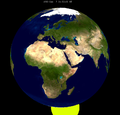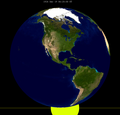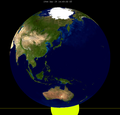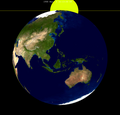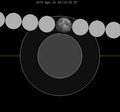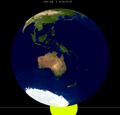
A total penumbral lunar eclipse is a lunar eclipse that occurs when the Moon becomes completely immersed in the penumbral cone of the Earth without touching the umbra. [1]
Contents
- Frequency
- Saros series with multiple consecutive total penumbral eclipses
- Summary frequency of total penumbral, total umbral and tetrad events 501–2500
- List of total penumbral lunar eclipse events 1901–2200
- See also
- Notes
- References
The path for the Moon to pass within the penumbra and outside the umbra is very narrow. It can only happen on the Earth's northern or southern penumbral edges. In addition, the size of the penumbra is sometimes too small where the Moon enters it to contain the Moon. The width of the Earth's penumbra is determined by the Sun's angular diameter at the time of the eclipse, and the Moon's angular diameter is larger than the Sun over part of its elliptical orbit, depending on whether the eclipse occurs at the nearest (perigee) or farthest point (apogee) in its orbit around the Earth. The majority of the time, the size of the Moon and the size of the Earth's penumbra where the Moon crosses it mean that most eclipses will not be total penumbral in nature.



